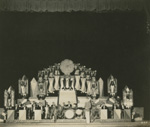The New York
Public Library for the Performing Arts > Vaudeville
Nation
Line dancing

Band Image
Photograph
of the finale of “Steppin’ High,”
showing the eccentric dance
team Walters & Russell on
the stairway.
J. A.
Partington Papers,
Billy Rose Theatre Collection
All but exhibition ballroom dance techniques could be performed
by groups. Small "pony" lines (of under 5' dancers), associated
with English pantomimes, especially those of dnace director
John Tiller, were popular in the 1900s and 1910s. Gertrude
Hoffmann, Ned Wayburn and other vaudeville and Broadway choreographers,
added special effects to the basic line vocabulary. They
could include props, such as parasols and hoops, costumes
divided vertically by color, and lighting effects from phosphorescence.
Prolog techniques
In the 1920s, the various theaters' teams of line dancers
could all do precision tap and kicks for each week's new
routine. Although only the Rockettes currently survive,
they had many contemporary rivals, among them the Roxyettes,
and the Fanchon & Marco Sunkist Beauties. Some theater
teams were known for their alternative virtuosities. The
Hippodrome, Capitol and Roxy Theaters and Radio City Music
Hall supported ballet troupes. The Capitol Theater's Chester
Hale Dancers were famous for their toe tapping; the Allan
K. Foster Girls were acrobats, as comfortable on a spider
web rigging as on the stage floor. The Gae Foster Girls
adapted to a wild variety of situations – dancing on skis,
roller skates, or bicycles.